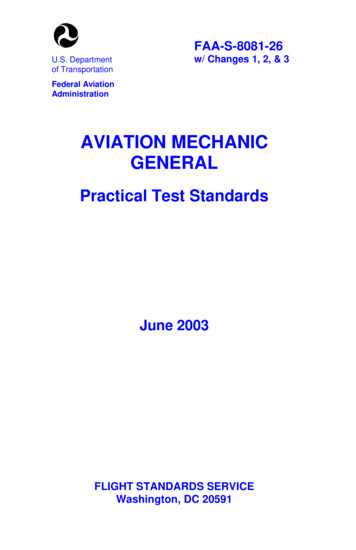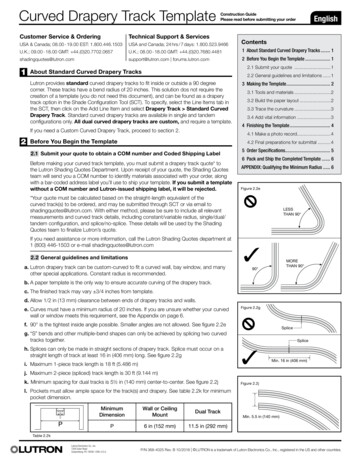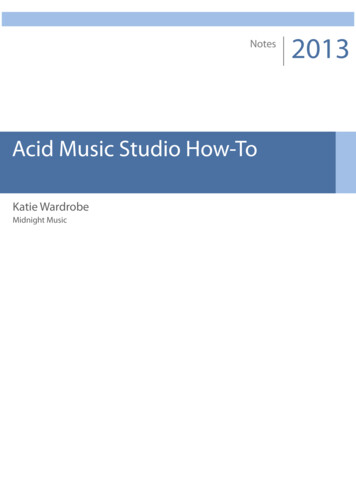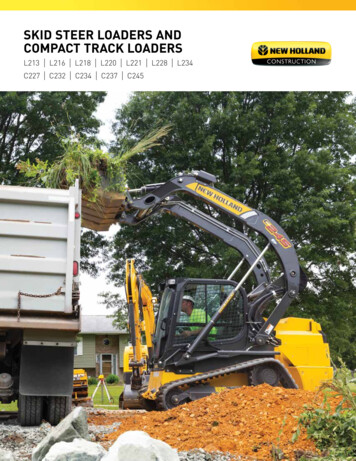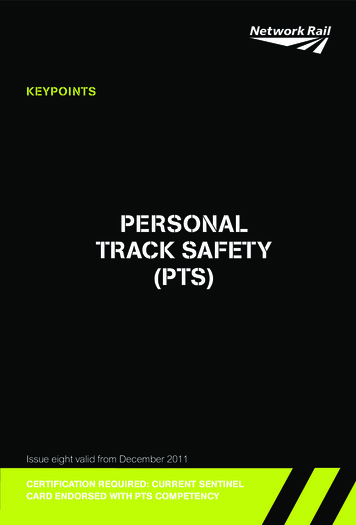
Transcription
KEYPOINTSPERSONALTRACK SAFETY(PTS)Issue eight valid from December 2011Certification required: Current SentinelCard endorsed with PTS competency
Keypoint Cards have been produced for many of the track safetycompetencies, as a reminder of the main duties, rules and requirements.Further copies are available from Willsons Group Services.To obtain an order form, email:denise@willsons.com(phone 01636 702334 or fax 01636 701396)
INFRASTRUCTURE AND TERMINOLOGYTrack otcessfour-footfour-foot‘On or near the line’ and ‘lineside’lineside3 metres (10 feet)on or near the lineplatform1.25 metres (4 feet)1
Running linesRunning lines are used by trains to go from place to place.Each running line has a name, speed limit and direction.Details are given in the Sectional Appendix.Position of safetyposition of safety1.25 metres (4 feet)2 metres (6 feet 6)101-125mph0-100mphLightweight tools and equipment must be left at least 2 metres(6 feet 6 inches) from the line, irrespective of the speed limit.Authorised walking routeAn authorised walking route provides safe access to or from aplace of work. These are often found near depots, stations andsignalboxes. Details are given in the Hazard Directory.2
Electrified linesConsider all electrification equipment to be live at all times.Overhead line equipment(OLE) provides trains with25,000 volts AC. You must treatthe OLE as being live at alltimes. Cables attached to thesestructure must be consideredto be live as well.Make sure you and anything you’re holding doesn’t comewithin 2.75 metres (9 feet) of live OLE.Take extra care when working: at height (on platforms, embankments, bridges) with metal equipment or liquids.Conductor rails (third rails)provide trains with up to750 volts DC. The live railis raised on insulating pots.Cables attached to these railsmust be considered to be liveas well.Make sure you and anything you’re holding doesn’t comeinto contact with a conductor rail. You must stand 300mm(1 foot) away from the third rail.Make sure you: use insulated tools, troughs and appropriate PPE take extra care when working with liquids or near floodwater.3
RAILWAY SIGNSNo position ofsafety on this sideof the railwayRefuges on otherside of the railwaybut not this sideLineside phoneSignal posttelephonePhone to electricalcontrol roomGeneral railway phones (often found at level crossings)Tel No:04 65239Phones in areas of limited clearance.4
GOING ONTO THE RAILWAYOnly go ‘on or near the line’ if absolutely necessary.Make sure you: have your Sentinel card with you wear the necessary approved PPE and suitable workwear know the speed and direction of approaching trains know any hazards which might affect your safety walk in a position of safety and face traffic, if possible take extra care in junction areas.Approved PPE5
WHEN A TRAIN APPROACHESYou must be in a position of safety at least 10 secondsbefore a train arrives.When a train approaches: stop what you are doing andgo to the position of safetystraight away acknowledge the driver’swarning by raising one armabove your head watch the train go past.Do not leave the position ofsafety unless you are sure noother trains are approaching.CROSSING THE LINEIf you have to cross the line: make sure there’s sufficient sighting distance and no trainsare approaching go straight across without stepping on rails or sleepers take care near points - your foot could get trapped check there is a position of safety on the opposite site.On lines with conductor rails: find a gap or a place where protective guarding is provided step over the running rail and conductor rail together.6
WALKING IN A GROUP AND WORKINGThe COSSWhen a group needs to walk or workon or near the line, a COSS sets upa Safe System of Work to make surenobody is put in danger by trains orelectrification equipment.They wear a blue badge or armlet with‘COSS’ in white letters.The COSS will tell you about the safety arrangements. Thisbriefing will include: the nature and location of the work the access route and route to site the limits of the site and how they are defined the lines at the site, their speed limit, direction and whetherthey are open or blocked the best means of emergency communication hazards at the site such as electrification equipment how you are protected from trains.The safe systemA Safe System of Work will be set up to protect you from trains.There are five options for a safe system 1. Safeguarded2. Fenced3. Site Warden warning4. Equipment warning5. Lookout warning7
Safeguarded: all lines are blocked.Fenced: a fence is put up between the site of work and nearestopen line. The distance between the fence and the open linedepends on the type of fence and speed of trains.Speed of trains:0-40 mphRigid barrierat least41-125 mphat least1.25 metres1.25 metresNetting/tapeat leastat least1.25 metres2 metresFor example: (below left) on a 30mph line, blue netting must be at least1.25 metres (4 feet) from the nearest open line (below right) on a 55mph line, barricade tape must be atleast 2 metres (6 feet 6 inches) from the nearest open line.COSS2 metres (6 feet 6)COSS551.25 metres (4 feet)308
Site Warden warning: a space is provided between the siteof work and nearest open line. The boundary of the work areadepends on the size of the group and whether a Site Warden isappointed.Boundary of thework areaat least2 metresat least2 metresat least3 metresSize of the groupSite Warden needed?1 or 2 peopleNoMore than 2 peopleYesAnyNoThe example below shows a group of four people with a SiteWarden at least 2 metres from the nearest open line.COSSSITEWARDEN2 metres (6 feet 6)A Site Warden warns you if you strayout of the Site Warden warning area.They wear a white badge or armletwith ‘SITE WARDEN’ in blue letters.Never distract a Site Warden.9
On an open line, you will be warned when a train isapproaching. You will be given enough warning to reach theposition of safety at least 10 seconds before the train arrives.The warning will be given by one of the following five methods.Automatic Track Warning System (ATWS): using lights andsirens and/or a personal warning device.Examples of ATWS and LOWS warning equipmentTrain Operated Warning System (TOWS): using sirens.Lookout Operated Warning System (LOWS): using lights andsirens and/or a personal warning device.Lookout: using a horn, whistle or touch.A Lookout wears a white badge or armletwith ‘LOOKOUT’ in red letters.Never distract a Lookout.10
BEYOND OR APPROACH‘Beyond’, is on the far side of the signalwhen looking in the normal direction oftraffic.‘On the approach’, is on the near side of asignal or points when looking in the normaldirection of traffic.(An example of a signal is given herehowever it could be a set of points or another fixed structure).These terms are used extensively on the railway you need toknow and understand their meaning.TAKING CARE WHEN USING METAL EQUIPMENTYou must not place objects e.g. measuring tapes or chainsacross the rails as it might operate the signalling equipment andchange a signal aspect in front of a driver.You must not allow any metal object near signalling equipmentor within 300mm (12 inches) of an axle counter head, as thiscould accidentally interfere with its operation.USING ROAD VEHICLES NEAR THE LINEWhen using a road vehicle on or near the line: You are the driver of the vehicle and are either a COSS orIWA, or COSS must be present and has given permission for thevehicle to be on or near the line11
You must: Not allow any part of the vehicle to come within 2m (6ft 6in)of any line Switch on hazard warning lights In darkness or poor visibility use dipped headlights Turn the vehicle only at a suitable turning point and keep theback of the vehicle furthest from the line Switch off all red lights when the vehicle is parkedBASIC EMERGENCY PROCEDURESNever put yourself in danger.If you see something which could be a danger to trains (or theCOSS requests you to): contact the signaller (or, if relevant, the electrical controloperator) straight away connect a Track Circuit Operating Clip between the tworunning rails (except in fourth rail areas) walk towards oncoming trains for 2km (11/4 miles) and placethree detonators on the rail 20 metres (20 yards) apart move at least 30 metres (30 yards) from the detonators display a hand danger signal to approaching trains from aposition of safety.To stopa train indaylight12
To stop a trainin darkness orpoor visibilityIn darkness or poor visibility, shine a red light orwave any light vigorouslyCOMMUNICATIONSKeep all messages accurate, brief and clear.If you are making an emergency call: start by saying “This is an emergency call” confirm you are speaking to the right person, e.g. thesignaller tell the other person your name, employer, job title, locationand contact number explain what has happened, the location and what actionneeds to be taken check that the other person has understood your messageand ask them to repeat it back to you wait for further instructions.Whenever you communicate by phone or radio: use the phonetic alphabet for difficult words and names say numbers one digit at a time.13
MAKE SURE YOUR MESSAGE IS UNDERSTOODTo make sure your message is understood:You must always speak: With the mouthpiece close to your mouth (but not too close) Directly into the mouthpiece Slightly slower than normal, with a natural rhythm At the same volume as you would in normal conversation.You must always: Use clear sentences Use normal railway words and phrases found in the rules,regulations and instructions Use the phonetic alphabet – to check your message isunderstood correctly Try to avoid hesitation sounds (for example, ‘um’ or ‘er’) andslurring one word into another If the other person responds or speaks in an accent ordialect which is unfamiliar, take time to make sure yourmessage is understood and that you understand his or hermessage.COMMUNICATION PROTOCOLIdentify yourself and your locationBe clear about the purpose of the callBe clear about who has lead responsiblitiyUse appropriate languageConfirm understanding14
PHONETIC ALPHABETPhonetic alphabetBe sure to pronounce numbers one digit at a time. For example,‘1702’ would be pronounced ‘one-seven-zero-two’. Always besure to say ‘zero’ for the figure ‘0’ and not ‘nought’ or ‘O’.Exceptions are as follows: When you refer to times, weights and measurements e.g.time 1317 hours should be stated as thirteen seventeenhours When you refer to Rule Book and Handbook modules e.g.T10, you may use T becRomeoWhiskyX-ray
PHRASES TO USEPhrases to use when using a radio or telephonePhraseMeaning‘This is anemergency call.’This message conveys information which requiresimmediate action to prevent death, serious injuryor damage.‘Repeat back.’Repeat all of the message back to me‘Correction.’I have made a mistake and will now correct theword or phrase just saidPhrases to use when using a radio and only one person canbe heard at a timePhraseMeaning‘Over.’I have finished my message and am expecting areply.‘Out.’I have finished my message and I do not expecta reply.Do not use phrases such as ‘not clear’ or ‘not safe’ to describe aline that is unsafe.Always use the phrase ‘line blocked’ to describe a line which isblocked to trains.16
Safety Central - The site is your one-stop shop of safetyinformation, advice, resources and useful contacts, designedto promote consistency and best practice across the whole railindustry.http://safety.networkrail.co.uk/There are two ways to report safety concerns. Your first stepshould be to tell your supervisor or sponsor. If this isn’t possible,you can contact CIRAS - the railway’s confidential reportingservice - www.ciras.org.uk
The purpose of this Keypoint Card is to act as a reminder only.If you are unsure about any issue relating to the informationgiven here, you must refer to the appropriate module of theRule Book GE/RT 8000 Series or Handbook.In supplying this document, Network Rail makes no warranties,expressed or implied, that compliance with all or anydocuments it issues is sufficient on its own to check safesystems of work or operation.Users are reminded of their own duties under health andsafety legislation.Network Rail, Kings Place, 90 York Way, London N1 9AGwww.networkrail.co.ukNR9922 Issue 8 2011 Network Rail
sirens and/or a personal warning device. Lookout: using a horn, whistle or touch. A Lookout wears a white badge or armlet . When you refer to Rule Book and Handbook modules e.g. T10, you may use T Ten A Alpha B Bravo C Charlie d Delta E Echo F G Foxtrot Golf h Hotel I India J Juliet K Kilo



